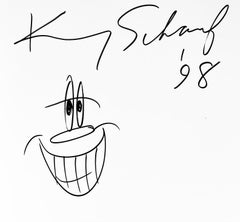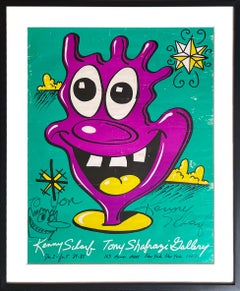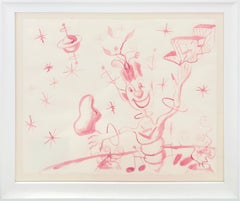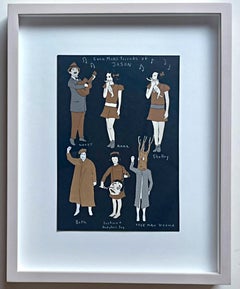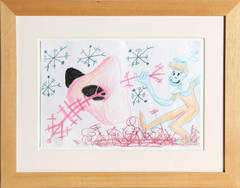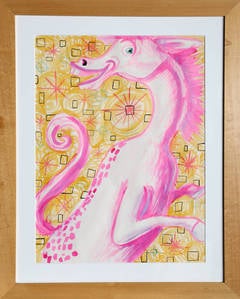Kenny Scharf Drawings and Watercolor Paintings
Kenny Scharf is a renowned artist affiliated with the 1980s-era East Village art movement in New York City.
Scharf developed a distinct and uniquely personal artistic style in paintings and prints as well as sculpture, alongside his mentor Andy Warhol, and contemporaries like Jean-Michel Basquiat and Keith Haring with whom he pioneered contemporary street art. References to popular culture reoccur throughout Scharf's works, such as appropriated cartoon characters from the "Flintstones" and "Jetsons," as well as imagined anthropomorphic creatures. Through ecstatic compositions and a dazzling color palette, he presents an immersive viewing experience that is both intimate and fresh.
Scharf's multifaceted practice — spanning painting, sculpture, installation work, murals, performance and fashion — reflects his dedication to the creation of dynamic forms of art that deconstruct existing artistic hierarchies, echoing the philosophy of Pop artists. Yet Scharf’s artistic significance expands beyond the art historical terrain of Pop art; the artist instead coined the term “Pop Surrealist” to describe his one-of-a-kind practice. His inclusion in the 1985 Whitney Biennial marked the start of his international phenomenon, a reputation that continues to thrive today.
Find original Kenny Scharf art on 1stDibs.
(Biography provided by End to End Gallery)
1990s Pop Art Kenny Scharf Drawings and Watercolor Paintings
Offset, Paper, Ink
1980s Pop Art Kenny Scharf Drawings and Watercolor Paintings
Permanent Marker, Lithograph, Offset
1980s Pop Art Kenny Scharf Drawings and Watercolor Paintings
Paper, Color Pencil
1980s Abstract Expressionist Kenny Scharf Drawings and Watercolor Paintings
Permanent Marker
1990s Pop Art Kenny Scharf Drawings and Watercolor Paintings
Watercolor, Ink, Handmade Paper, Graphite
Early 2000s Pop Art Kenny Scharf Drawings and Watercolor Paintings
Paper, Ink, Board, Offset
1910s Fauvist Kenny Scharf Drawings and Watercolor Paintings
Ink, Pen
1950s Modern Kenny Scharf Drawings and Watercolor Paintings
Pen
Early 2000s Pop Art Kenny Scharf Drawings and Watercolor Paintings
Paper, Mixed Media, Color Pencil, Graphite, Offset
Richard PrinceUntitled (de Kooning) Collage, offset lithograph hand-cutting, hand-paint Signed, 2008
1980s Pop Art Kenny Scharf Drawings and Watercolor Paintings
Paper, Ink, Acrylic, Watercolor
1950s Pop Art Kenny Scharf Drawings and Watercolor Paintings
Paper, Ink, Graphite
Mid-20th Century Pop Art Kenny Scharf Drawings and Watercolor Paintings
Paper, Watercolor, Pencil
20th Century Abstract Kenny Scharf Drawings and Watercolor Paintings
Pen
Early 2000s Pop Art Kenny Scharf Drawings and Watercolor Paintings
Paper, Ink
1960s Pop Art Kenny Scharf Drawings and Watercolor Paintings
Graphite
1980s Pop Art Kenny Scharf Drawings and Watercolor Paintings
Crayon, Paper
1980s Pop Art Kenny Scharf Drawings and Watercolor Paintings
Permanent Marker
Kenny Scharf drawings and watercolor paintings for sale on 1stDibs.
Artists Similar to Kenny Scharf
- What is Kenny Scharf known for?1 Answer1stDibs ExpertApril 5, 2022Kenny Scharf, who coined the term “Pop Surrealist”, is known for pioneering street art and for his numerous references to pop culture and cartoon characters in his work. His art is exciting and colorful, creating an immersive experience for the viewer. Find original Kenny Scharf art on 1stDibs.
